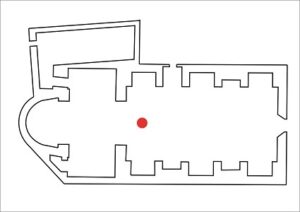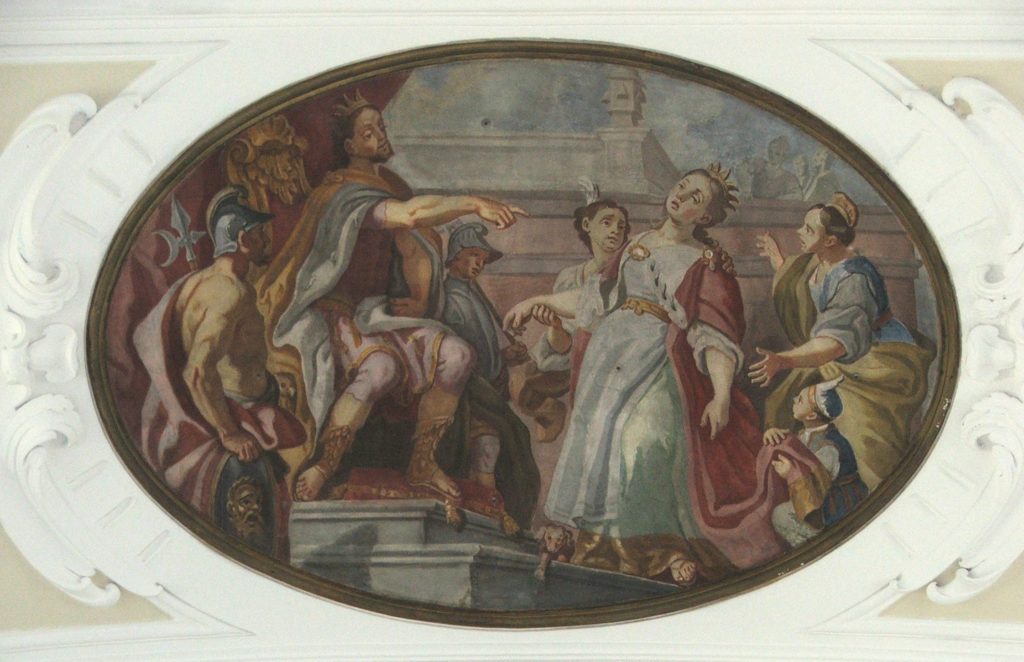Ester e Assuero


Chiesa di S. Maria Maggiore
Dipinto
Matteo Vigilante
Ester e Assuero
Sec. XVIII (dat. 1768)
Affresco

Church of S. Maria Maggiore
Painting
Matteo Vigilante
Esther and Ahasuerus
18th century (date 1768)
Fresco
Il dipinto ad affresco, opera di Matteo Vigilante, pittore di origine solofrana, rappresenta la scena biblica dell’incontro di Ester e Assuero dopo l’editto contro gli ebrei.
Ester, una giovane ebrea deportata da Gerusalemme durante l’invasione di Nabucodonosor , re di Babilonia, orfana di padre e di madre, è adottata come figlia dal cugino Mardocheo. Il re Assuero, passato alla storia con il nome di Serse I, il potentissimo re persiano che regnava dall’India fino all’Etiopia “sopra centoventisette province”, cerca una moglie tra le ragazze del suo regno. Vengono radunate tutte le vergini nel palazzo di Susa e tra queste Ester che sarà la prescelta. Allora il nuovo primo ministro di Assuero, Amàn, esige che ognuno si prostri dinanzi al re Assuero. Mardocheo rifiuta, perché un ebreo si genuflette solo davanti al suo Dio. Il ministro diviene furioso e convince il re ad emettere un editto reale con l’ordine di sterminare gli ebrei.
Ester, la promessa sposa, deve intercedere presso il re per il suo popolo. Dopo tre giorni di preghiera, indossa abiti sontuosi e, accompagnata da due ancelle, si dirige dal re.
Il dipinto rappresenta proprio questo incontro, che così viene descritto nei testi biblici: “Egli è seduto sul trono regale … con un aspetto molto terribile. Alza il viso splendente di maestà e guarda in un accesso di collera. La regina si sente svenire … e poggia la testa sull’ancella che l’accompagnava”.
La vicenda si completa con il matrimonio tra Ester e Assuero e il popolo ebraico viene liberato.
Il dipinto è ispirato ad un’opera di Paolo Di Maio, maestro del Vigilante. Le due raffigurazioni sono pressoché identiche con l’aggiunta di alcuni particolari che si ritrovano spesso nell’opera pittorica del Vigilante, il cagnolino ai piedi del Re, e soprattutto la quinta scenografica della città murata e turrita.
The fresco painting, by Matteo Vigilante, a painter of Solofrana origin, represents the biblical scene of the meeting of Esther and Ahasuerus after the edict against the Jews.
Esther, a young Jewish woman deported from Jerusalem during the invasion of Nebuchadnezzar, king of Babylon, an orphan of father and mother, is adopted as a daughter by her cousin Mordecai. King Ahasuerus, who went down in history with the name of Xerxes I, the very powerful Persian king who reigned from India to Ethiopia “over one hundred and twenty-seven provinces”, is looking for a wife among the girls of his kingdom. All the virgins are gathered in the palace of Susa and among these Esther who will be the chosen one. Then the new prime minister of Ahasuerus, Aman, demands that everyone prostrate himself before king Ahasuerus. Mordecai refuses, because a Jew genuflects only before his God. The minister becomes furious and convinces the king to issue a royal edict with the order to exterminate the Jews.
Esther, the betrothed, must intercede with the king for his people. After three days of prayer, she wears sumptuous clothes and, accompanied by two maidservants, heads to the king.
The painting represents precisely this encounter, which is thus described in the biblical texts: “He is seated on the royal throne … with a very terrible aspect. He raises his face resplendent with majesty and looks with a fit of anger. The queen feels faint … and rests her head on the handmaid who accompanied her”.
The story is completed with the marriage between Esther and Ahasuerus and the Jewish people are freed.
The painting is inspired by a work by Paolo Di Maio, master of the Vigilante. The two representations are almost identical with the addition of some details that are often found in the pictorial work of the Vigilante, the dog at the King’s feet, and above all the scenographic backdrop of the walled and turreted city.

